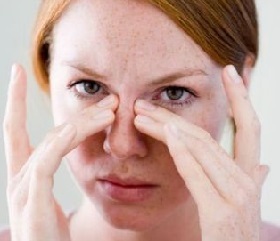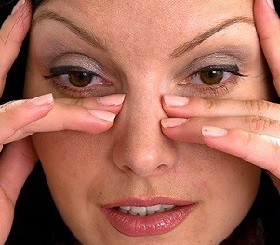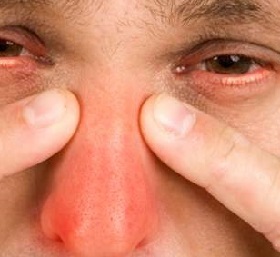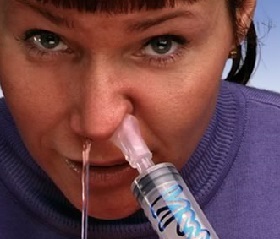 Genyantritis is one of the types of sinusitis, which is characterized by inflammation of the maxillary sinus. It is an acute or chronic inflammation of the maxillary sinus.
Genyantritis is one of the types of sinusitis, which is characterized by inflammation of the maxillary sinus. It is an acute or chronic inflammation of the maxillary sinus.
The name of the disease comes from the name of the sinus, the defeat of which causes the disease. The inflammatory process affects one or both of the maxillary sinuses located in the area of the nose, around the eyes, behind the cheeks and forehead.
Sinusitis is often accompanied by a cold and can cause headache or pressure in the eyes, nose, cheek areas or on one side of the head. A person suffering from sinusitis can also have a cough, high fever, bad breath and a runny nose. In addition to this, a person's memory worsens, working capacity decreases and fatigue increases.
It should be noted that if you do not start to treat sinusitis at the initial stage, then it will grow into the next, purulent stage. As a result, you will have other serious illnesses. About sinusitis, symptoms and treatment of this disease will be discussed in our article.
Causes
The main cause of acute sinusitis is acute respiratory infection, the spread of infection in diseases of the teeth (odontogenic sinusitis), allergic reaction (allergic sinusitis). If the acute sinusitis is not completely cured, it goes into a chronic form - there is a long purulent bacterial inflammation of the maxillary sinuses.
To become the reason of a genyantritis can and a curvature of a nasal septum, presence of chronic centers of an infection in a cavity nose and mouth (for example, chronic pharyngitis, chronic tonsillitis, chronic rhinitis, adenoids).
The main link in the mechanism of development of both acute and chronic sinusitis is the clogging of the exit aperture of the maxillary sinus, leading to inflammation and accumulation of pus inside it. Occur such a blockage can, for example, against the background of ARI, when the nasal mucosa swells and inflames. To become the reason of a genyantritis the chronic rhinitis which causes a thickening of a mucous nose can also.
The disease affects both adults and children, especially in the cold season. Determine how to treat sinusitis, symptoms. Therapy of the chronic and acute phase is significantly different.
Symptoms of genyantritis
 In most cases, sinusitis can be identified by characteristic symptoms. Mucocutaneous watery discharge from the nose does not in itself mean sinus infection.
In most cases, sinusitis can be identified by characteristic symptoms. Mucocutaneous watery discharge from the nose does not in itself mean sinus infection.
However, one can assume sinusitis if the runny nose lasts more than a week and is accompanied by the following symptoms:
- thick, yellow-green discharge from the nose;
- pain in the sinuses, which increases with the tilt or strain of the muscles of the face;
- a runny nose, accompanied by a sore throat and cough;
- toothache;
- headache.
Sometimes sinusitis is accompanied by swelling of the eyelids, redness of the eyes, swelling of the cheeks, lacrimation and photophobia. Often there are additional symptoms of sinusitis - chills, loss of appetite and insomnia.
It is recommended to consult a doctor if an adult or a child:
- the runny nose does not go away after self-treatment for 7 days;
- the condition worsens after 3 days of self-treatment, the temperature is above 38 degrees;
- sinusitis was earlier;
- pain in the eyes, visual disturbances, redness on the face around the eyes.
Sinusitis can occur in acute or chronic form (the symptoms of sinusitis do not last for 8 weeks or more). Chronic sinusitis must necessarily be cured, as it changes the state of the mucous membrane of the sinuses so that a person becomes more susceptible to infections in the future.
Symptoms of chronic sinusitis
All the symptoms of chronic sinusitis in adults without exacerbation can be expressed quite weakly. Usually a person suffering from this disease complains of constant nasal congestion, a violation of smell, a change in the timbre of the voice, and also aching pain in the nose. There is also a constant feeling of fatigue. It is worth noting that there can be no exacerbation of pain.
Exacerbation of chronic maxillary sinusitis, as a rule, is accompanied by deterioration of health, a rise in temperature, headache, swelling of the eyelids and swelling of the cheeks. The outflow of pus from the nasal sinus increases with the inclination of the head. Excretions from the sinuses irritate the mucous membrane, as a result, it becomes swollen and reddened. There may be polyps.
Diagnostics
Diagnosis of sinusitis, whether acute or chronic sinusitis, is performed by an experienced ENT doctor and includes examination sinus, taking a smear to identify the causative agent of the infectious process, x-ray of the maxillary sinuses.
Based on the results of the examination, the ENT doctor appoints individually selected therapy for both primary and identified co-morbidities. Timely diagnosis is really necessary if you decide to cure maxillary sinusitis quickly.
Treatment of genyantritis
 Before the treatment of maxillary sinitis, first of all, a correct diagnosis is necessary. The doctor makes an opinion about the disease after an external examination, carefully listening to the patient's complaints.
Before the treatment of maxillary sinitis, first of all, a correct diagnosis is necessary. The doctor makes an opinion about the disease after an external examination, carefully listening to the patient's complaints.
The most reliable is the X-ray study. Often this study can be limited to one. If traditional methods of research do not show the entire clinical picture (complicated, neglected cases), the patient undergoes a puncture of the affected sinus.
In the case of maxillary sinusitis treatment is carried out the more successfully and faster than before it was started. Therapeutic measures are aimed at normalizing the movement from the sinus to the nasal cavity of mucus and air, to destroy disease-causing agents that provoked the disease. As already known, inflammation of the maxillary sinus causes swelling, which clogs the ducts that run from the nose into the sinus cavity; as a consequence - purulent congestion. While the outflow of pus will not be adjusted, one can forget about recovery.
To do this, discharge vasoconstrictive drops from the sinusitis, or sprays with a similar effect. Modern drops almost instantly remove the swelling and restore (albeit temporarily) the drainage of the cavity. We remind you that prolonged use of vasoconstrictive drops in sinusitis is fraught with atrophy of mucous membranes. Therefore, five days is the maximum period of their application.
In sinusitis, as a treatment, the sinuses of the paranasal sinuses are also washed (without puncture) and they are used only if there is severe pain or copious pus.
Laser therapy is performed to eliminate the effects of inflammation and enhance the effect of drug treatment. In a number of cases (for example, during a severe course of the disease), treatment with an otorhinolaryngologist should be combined with acupuncture and the intake of biologically active additives. Completely the course of treatment of an acute process takes depending on the severity of two weeks to two months.
Puncture of the maxillary sinus
The puncture of the maxillary sinus can be prescribed both for the purpose of diagnosis and for the treatment of sinusitis. Puncture is done under local anesthesia. The sinus wall is punctured with a special needle, sucked out pus and washed with antimicrobials.
If the appointment of antibiotics is not desirable, you can apply Sinuforte, a preparation based on cyclamen extract, which enhances local immunity, triggers the mechanism of natural cleansing of the nasal cavity and colonosal sinuses from mucus and pus.
From the point of view of preventive medicine, the use of antibiotics is highly undesirable for a number of reasons, including taking into account their side effects. Sinuphorte is a good alternative. For patients with chronic forms of sinusitis or sinusitis, it is important that Sinuphorte is not addictive. The medicine is used once a day, for 6-8 days, alone, or in a comprehensive treatment regimen.
Antibiotics for sinusitis
Treatment of sinusitis with antibiotics is a very effective method, but only if the nature of the disease is not viral and not allergic.
- Ampicillin. One of the most well-known antibiotic drugs, is available in tablets, in capsules, taken on a tablet of 0.25 g, 3 times a day. There are injections with ampicillin.
- Cephalexin. Antibiotics in the form of tablets take in 0.25-0.5 g, 3 - 4 times a day. Injections do 0.5 to 1 g, 2 times a day.
- Augmentin. A modern powerful drug with a pronounced antibiotic effect. Tablets of 625 mg, taken 2 times a day before meals. It is also available in the form of syrup.
Antibiotics for sinusitis are selected taking into account all the attendant factors. The main treatment of sinusitis at home.
Treatment of sinusitis in the home
 At home, the treatment of sinusitis is supplemented by washing the sinuses with an antiseptic solution. For example, Furacilin, suppressing streptococci and staphylococci.
At home, the treatment of sinusitis is supplemented by washing the sinuses with an antiseptic solution. For example, Furacilin, suppressing streptococci and staphylococci.
Half of the Furacilin tablet is crushed and dissolved in half a liter of warm water. Treatment can also be performed with saline at a rate of 1 tsp. salt on a glass of warm water.
Leaning over the sink and turning your head slightly until one nostril is higher, pour the liquid with a syringe into the upper nostril, so that it flows out of the lower nostril. Half a liter of antiseptic solution on each side is enough.
You can pour a little solution into the palm, clamp the upper nostril, and draw the contents of the palm with the bottom. The inclination of the head should not be too large. Then press the lower nostril with your finger and tilt the head in the opposite direction. The antiseptic solution must flow independently from the other nostril.
After washing the nose, you can not lie on the right or left side, since bacteria can enter the liquid residues, causing otitis media, inflammation of the middle ear.
How to treat sinusitis with folk remedies
Folk medecine is an excellent addition to medical therapy, combining naturalness, softness, efficiency, painlessness, low cost and lack of toxicity.
- Prepare carrot juice (a third of the glass), add 1h. spoon of alcohol tincture of propolis and 0.5 h. spoons of flower honey (if honey thickens, it should be slightly heated in a water bath). The resulting mixture soak small cotton swabs and insert into the nose for 15-20 minutes 2-3 times a day. The remainder of the medicine should be kept in the mouth on the side of the affected sinus for 2-3 minutes.
- If there is a tendency to sinusitis, immediately cure any runny nose. To quickly and without complications pass, you can use the following recipe. Take 100 g of olive or sunflower oil and 1 tbsp. A spoon with the top of a crushed ledum. Place for 3 weeks in a dark place, shaking daily. Strain and wring out the grass. Bury 2-3 drops in each nostril for the first time, and then 1 drop 3-4 times a day for not more than a week. Acute rhinitis occurs after a few days, chronic - in 2 weeks.
- At home, treatment of sinusitis can be done with self-massage. This procedure should complement other methods of treatment, but not be an independent method of treatment of the disease. There are reflexogenic points, pressure on which will stimulate the process of self-healing of the mucous membrane of the maxillary sinuses. In eastern medicine, rubbing eucalyptus or rose oil into these points is used.
- It is necessary to grind the onion on a small grater. Binding your eyes with a dense bandage, you need to cover your head with a towel and breathe over the chopped mass for 1-2 minutes. Thanks to such inhalation, onion medicinal essential oils and phytoncides penetrate the area of the maxillary sinuses.
- Several laurel sheets should be put in a saucepan. Further, they are poured with water and brought to a boil. After the water boils, put in a decoction sterile napkin or scarf to soak the broth. Then the handkerchief is applied to the frontal part and the bridge of the nose. It is necessary to cover the head with a cloth to keep the heat as long as possible. And after the kerchief has cooled, repeat the procedure 2-4 times. Duration of treatment is 6-7 days.
- Sea salt is often used for home treatment as salt flushing - a cup of chamomile broth (water) is divorced st.l. salt.
- Than still to treat a genyantritis? With the help of inhalations! Boil 1 kg of potatoes in the peel, water after cooking should be drained. And above the potato breathe mouth, nose, before covering his head with a towel so that the steam from the potatoes does not evaporate. The time of this procedure is not limited to who can how much. After inhalation, wipe with a towel and lie on the sofa without a pillow, tilt the head slightly back and into each nostril, drip 2 drops onion composition (15 drops of onion juice and 15 drops of 96% alcohol, mix) It will be hard to burn, but after 20 seconds everything will pass.
- Squeeze juice from aloe vera - 2 tablespoons, calanchoe pinnate and onion - 1 tablespoon. Mix and bury in the nose.
- Cyclamen juice quickly removes purulent contents from the sinuses of the nose, immediately stops the headache, arising from the pressure on the maxillary sinuses. In each nostril you need to drip 2 drops of juice. After 5 minutes the patient begins to sneeze, cough, feel the heat in the body, sweat. After that, a thick yellow-green pus will be released from the nose during the day. You can buy a ready-made drug with the cyclamen juice - Sinuforte.
Remember that all folk methods of treatment can have individual contraindications, before using recipes, discuss them with your doctor!

How to choose probiotics for the intestine: a list of drugs.

Effective and inexpensive cough syrups for children and adults.

Modern non-steroidal anti-inflammatory drugs.

Review of tablets from the increased pressure of the new generation.
 Antiviral drugs are inexpensive and effective.
Antiviral drugs are inexpensive and effective.



